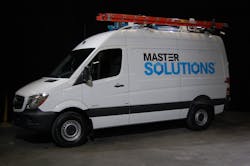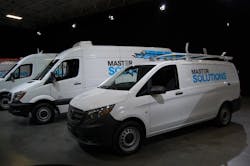New U.S. factory planned for Sprinter vans in four years
NORTH CHARLESTON, SC. Mercedes-Benz Vans LLC, a division of global truck maker Daimler AG, plans to invest around $500 million and creating potentially up to 1,300 jobs to build a new manufacturing facility in North Charleston, SC, for its Sprinter van as it seeks to capitalize on growth in the commercial van segment.
The new facility will cover around 1.1 million sq. ft., in addition to a 2.8 million sq. ft. marshaling yard for finished vehicles, and is expected to be completed “sometime at the end of this decade,” noted Volker Mornhinweg, head of Mercedes-Benz Vans, at a groundbreaking event held here at its current 409,000 sq. ft. assembly facility in North Charleston.
“The key to our success is a strong global presence,” said Mornhinweg, but the U.S. market has become a much more critical part of the “global success” in recent years, he stressed.
Indeed, Mornhinweg pointed out that the U.S. is one of the fastest growing van markets in the world and is now the second-largest single market for the Sprinter in terms of unit sales after Germany as in 2015, Mercedes-Benz Vans delivered about 28,600 units to U.S. customers; some 11% more than in 2014.
Since 2006, Sprinter vans for the North American market – largely the U.S. and Canada – are first built at the company’s plants in Düsseldorf and Ludwigsfelde, Germany; plants that are also going to be upgraded to the tune of $450 million Euros, which is roughly $499 million U.S. However, because of high import tariffs of nearly 25%, Mercedes-Benz Vans partially dismantles its fully-built Sprinters in Germany “in a time-consuming process,” packages the body in one shipping container and engines, transmissions, axles, etc., in a separate one, sends them to the Port of Charleston by sea, and then reassembles the vehicle at its current North Charleston facility – with each vehicle taking 4 to 5 hours on average for full re-assembly.This so-called semi-knocked-down or “SKD” assembly procedure for imported Sprinter vans and, since 2015, its mid-size brother, the Metris (known as the "Vito" in other markets) results in a “significant competitive disadvantage” in the U.S. market for Mercedes-Benz Vans, the company explained.
“The new plant, with Sprinters ‘made in USA,’ will enable the company to more economically meet the growing demand and to considerably reduce delivery time to this market,” noted Michael Balke, incoming CEO of Mercedes-Benz Vans, LLC and director of production.
Nikki Haley, Governor of South Carolina, attended the event as well and noted that she hopes to see the new Sprinter plant in North Charleston up and running ahead of schedule. “Daimler has expanded the Mercedes-Benz plant three times in the last 10 years, so I think we’re going to see more of these Sprinter vans across the country,” she said.
To date, the main markets for Mercedes Benz Vans remain Western Europe, accounting for a total of 65% of unit sales in 2015, according to executives here.
Yet as part of its "Mercedes- Benz Vans goes global" growth strategy, the company said it is planning to “beef up activity” in the “growth markets” of South America and Asia, as well as the Russian market, by initiating locally adapted sales and production activities.
“We don’t have a crystal ball, but we also see steady growth in the U.S. and Canadian market,” Mornhinweg added.
The biggest opportunities for van sales right now, he said, are for recreational vehicles (RVs) and cab chassis. “There is demand for specialized bodies that our upfitters can put on the back,” Mornhinweg pointed out.
About the Author
Sean Kilcarr
Editor in Chief
Sean Kilcarr is a former longtime FleetOwner senior editor who wrote for the publication from 2000 to 2018. He served as editor-in-chief from 2017 to 2018.

